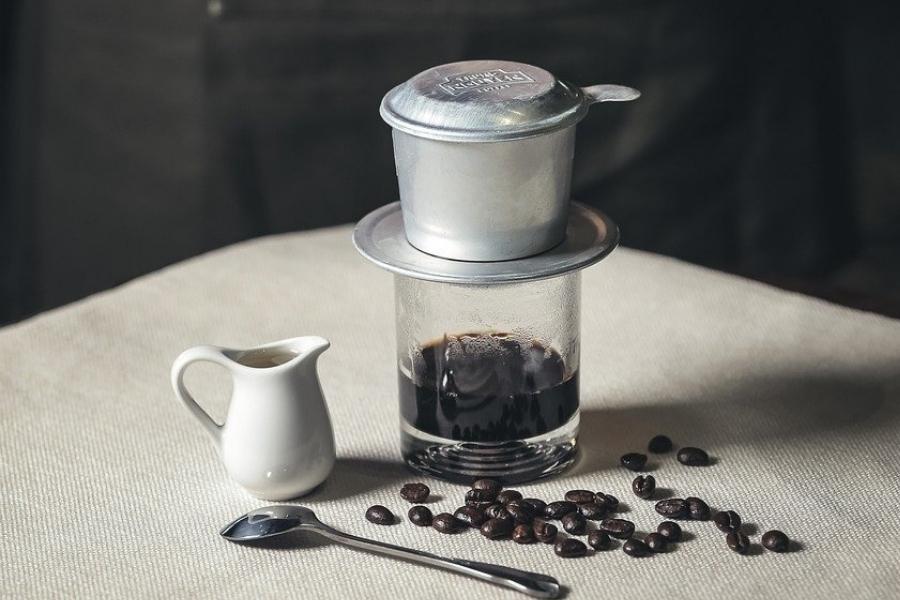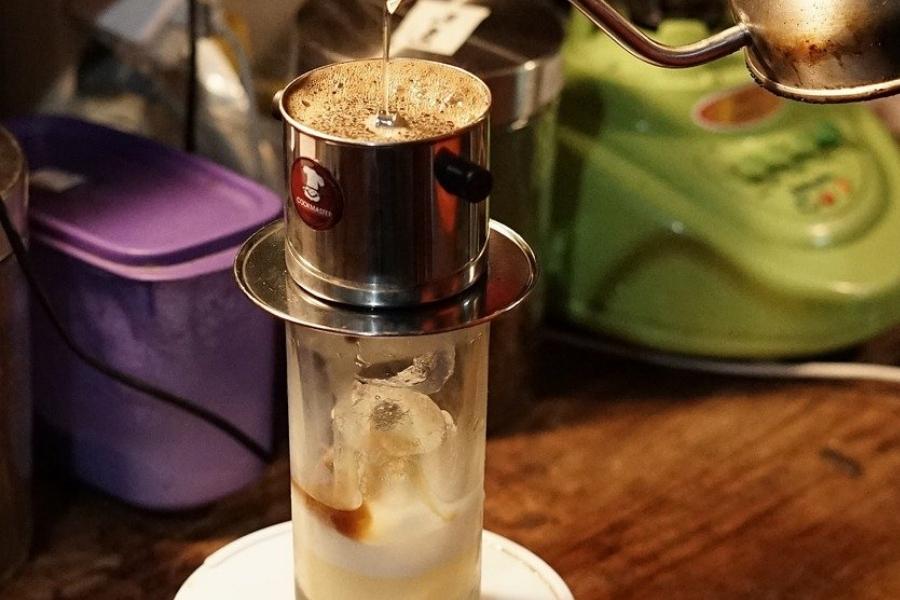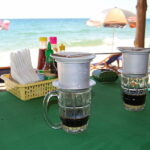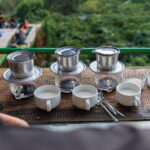If you’ve ever tried Vietnamese coffee, you’re probably familiar with the intense caffeine hit you feel after drinking it. Vietnamese coffee is one of the most popular types around the world. Read on to find more on why Vietnamese Coffee is so strong.
Contents
Why Is Vietnamese Coffee So Strong?
Vietnamese coffee is so strong because of the Robusta beans used in making it. Robusta beans are known for their intense flavor, high caffeine content, and earthy aroma. The coffee also involves a unique brewing method that allows more time to extract the flavors from the beans.
Combining the darkness of the roast and the brewing method gives Vietnamese coffee its strong taste. Vietnamese coffee flavors are deep, complex, and just a little bitter. It has a unique taste profile and high caffeine content, making it ideal for serving espressos or cold freezer drinks.

Vietnamese Coffee Beans
Robusta beans have an earthy taste with chocolate, caramel, and nuts hints. They are extremely dark roasted and ground up into a fine powder.
Vietnamese coffee is made with dark-roast Robusta coffee beans, brewed slowly over condensed milk. It’s strong, sweet, and delicious. So it’s no wonder that Vietnamese coffee is such a popular morning drink in the Southeast Asian country.
In addition, Vietnamese coffee has a high caffeine content due to the type of beans used. Most of the coffee I see and drink in America is made from Arabica beans. Robusta beans have twice as much caffeine as Arabica beans and a richer flavor.
Roasting Coffee Beans
In Vietnam, coffee beans are roasted at a lower temperature than in other countries. The roasting process is usually done at around 194 Fahrenheit, lower than most American roasters of 300 degrees Fahrenheit. This gives Vietnamese coffee a less acidic taste and more of a deep, rich flavor.
The process involves roasting the beans at a low temperature while being constantly fanned by cool air. The beans then go through a cooling process that lasts several hours. A higher temperature is applied, only for a short period so that the beans do not become burnt.
This unique roasting method allows for more flavor to be retained in each bean and creates a wonderfully smooth flavor profile. It makes Vietnamese coffee more bitter however some people prefer this as it gives them energy for their day!
Brewing Style
Vietnamese coffee is brewed strongly with the standard ratio of coffee to water between 1:10 and 1:14. Vietnamese coffee is brewed in a small filter that rests on a glass cup or mug. The coffee drips slowly into the cup or mugs to create a strong brew.
If you like your coffee sweet, rich, and with a hint of coconut, then Vietnamese coffee is for you. The brewing style is meant to create a strong, flavorful brew. It’s all about balance and complexity, and it’s not difficult to brew at home, even for a coffee novice.
The Vietnamese quickly adopted their brewing style, which they preferred over traditional European-style techniques. The French-style press pot was replaced by the single-serving Phin drip filters, now synonymous with Vietnamese-style coffee.
The Phin Filter Method
The Vietnamese Phin is a metal filter that sits on top of your mug or cup. It’s low-tech and easy to use, and the results are exceptional. The key to making good Vietnamese coffee is using very coarse ground dark roast beans. Here’s the brewing process:
- To start, you just need some ground coffee and boiling water. A metal Phin filter with a spring-loaded plate on top of it will help press the coffee down into the water.
- Now add your coffee grinds. You can use about two to three tablespoons of ground medium roast Vietnamese coffee grinds.
- Pour boiling water over the grounds until the chamber is full, then stir it a little bit to make sure all the grounds are wet.
- Wait about one minute for the coffee to steep and bubble up a little, then put the filter lid on top and pour in more hot water to fill the remaining space in the chamber.
The idea is that as you pour in boiling water, it will force its way through your coffee grounds and drip down into your cup. The longer you let it sit, the stronger your brew will be, and the more bitter the coffee becomes.

How Does Phin Method Make Vietnamese Coffee Stronger?
The concept behind Phin Method is simple: The larger opening at the top of your metal filter allows more water to go through faster, which means less time for your coffee grounds to steep and become over-extracted and bitter tasting.
The high oil content in Vietnamese beans makes the coffee thick and flavorful. The Phin filter releases more oils from beans during brewing, making it stronger than other brewing methods.
French Press Method
Vietnamese Coffee is a great way to elevate your caffeine experience. Here are the steps to brew Vietnamese coffee using the French press method:
- Fill the filter with famous Vietnamese coffee beans and place it in the french press.
- Pour in hot water so that it just covers the grounds and does not saturate them. Slowly stir the grounds for about 10 seconds to ensure that the water has wetted all grounds.
- Let the grounds sit in the water for about three minutes, letting them steep and absorb water.
- Use a spoon to separate the grounds from the still-hot water and push them down into the filter section of your french press, keeping them as far away from the spout as possible, so you don’t clog it when you go to pour into your cup.
- Pour sugar into your cup until it is about one-fourth full, then pour in Trung Nguyen’s sweetened condensed milk until it is about half full.
- Pour coffee out of french press over the top of sweetened condensed milk and sugar, then stir well until all ingredients are thoroughly mixed. If the coffee is uniform in color throughout the cup, you can add ice.
What Is the Background of Vietnamese Coffee?
Vietnam comes in second in the production of coffee in the world after Brazil. The country has a long history of growing and exporting coffee; however, the world’s first coffee plant was discovered in Ethiopia in the sixth century.
It wasn’t until the 19th century that Vietnam became a major player in the global industry. The country’s ideal weather conditions and rich soil have turned much of Vietnam into one giant coffee plantation, with around 500 million coffee trees grown throughout the nation. Farmers mainly grow robusta beans rather than arabica beans.
The style of coffee brewing has been around for more than 100 years. The Vietnamese were introduced to coffee in the late 19th century when the French colonized Vietnam. Coffee was only consumed by the elite at first and became accessible to everyone in the 1920s.
How Strong Is Vietnamese Coffee Compared to Espresso?
Vietnamese coffee is usually much stronger than espresso since it is brewed by steeping ground coffee in a filter. This is not like forcing hot water through a puck of tightly packed ground coffee.
You can compare it to making a cup of tea with loose-leaf tea and brewing it with tea bags. In addition, the steeping process used to brew Vietnamese coffee tends to leave a lot more oil behind in the cup than an espresso machine.
This makes Vietnamese coffee taste richer and fuller. It also tends to make it cloudier and leave more sediment at the bottom of the cup. How the coffee is served differently from an American espresso also has a direct effect on its strong taste.
Taste of Vietnamese Coffee
The taste of Vietnamese Coffee is complex and layered. A thick layer of fragrant crema floats on top of a dark liquid from which emanates a strong aroma of roasted beans. The taste is mouth-filling, velvety, and holds a slight bitterness that cuts through the sweetness.
The flavor of Vietnamese coffee can be compared to Italian espresso because it has its unique characteristics originating from the particular method of preparation and the specific ingredients used. The taste of the coffee is sweet, rich, and smooth in texture.
It has a hint of bitterness from the dark roasted beans. If that is your preference, it’s still very balanced with sweetness from condensed milk. You can choose to drink it hot or iced for a refreshing treat in the hot summer weather.
Serving Vietnamese Coffee
In Vietnam, coffee is typically served black with sweetened condensed milk poured into the bottom of a small cup or glass. The sweetened condensed milk saves you from adding sugar later as a bonus! This style of coffee is known as cà phê đá.
Vietnamese coffee is often made with a type of condensed milk that is different from most of the other types of condensed milk used in coffee. The Vietnamese condensed milk has a lower sugar content, so it’s not as sweet when you add this to your coffee.
The sweetened condensed milk is added to hot, freshly brewed coffee and then poured over ice. This makes for an incredibly rich and creamy cup of coffee with a smooth texture. Vietnamese iced coffee is made with dark roast beans brewed and is often served with sweetened condensed milk.

What Is the Caffeine Concentration in Vietnamese Coffee?
Coffee can be strong, and it’s mostly water therefore, the exact measurement of caffeine concentration will depend on your method of preparation. The caffeine concentration in Vietnamese coffee depends on how much condensed milk and water one uses to dilute the espresso.
If you drink an eight-ounce cup of Vietnamese coffee with two shots of espresso and three tablespoons of condensed milk, the caffeine concentration will be about 18.7 milligrams per ounce, about double that of regular drip coffee.
However, if you drink an eight-ounce cup of Vietnamese coffee with two shots of espresso and three tablespoons of condensed milk, the caffeine concentration will be about 36 milligrams per ounce, about triple that of regular drip coffee.
How Strong Is Vietnamese Coffee Compared to an Energy Drink?
A single cup of Vietnamese coffee can have anywhere from 50 to 80 milligrams of caffeine. By comparison, a single serving of Red Bull contains 80 milligrams of caffeine. This means that Vietnamese coffee can be as strong as an energy drink, depending on the amount you consume.
Well, most energy drinks contain between 80 and 200 milligrams per can or a 16-ounce bottle. Vietnamese coffee is more natural than energy drinks in that it does not contain any harmful additives or ingredients.
Vietnamese coffee does not always require sugar because it is naturally sweet. In comparison, energy drinks are full of unhealthy ingredients like sugar and preservatives.
Related Questions
The most asked questions about Vietnamese Coffee include:
What’s the Difference Between Vietnam Coffee and Regular Coffee?
Vietnamese coffee is made from a mixture of strong Robusta beans giving it a strong flavor. Regular coffee is made from regular Arabica beans so it does not have a strong taste. The process for making Vietnamese coffee is different from brewing regular coffee.
Why Is Vietnam Coffee Popular?
It takes more effort to prepare, which gives it a much different taste than drip or instant coffee. The coffee is made by pouring hot water over medium to ground dark-roast beans and steeping the mixture. The coarse grounds are filtered out leaving a concentrated, bold brew.
Which Is the Strongest Coffee?
There’s no doubt that Vietnamese coffee is stronger than other coffees. It’s brewed with a darker roast than other coffees, and it’s brewed stronger overall. A typical cup of Vietnamese coffee has about twice as much caffeine as other coffees do.
Conclusion
So, why is Vietnamese coffee so strong? This coffee is a result of the strong Robusta coffee beans that contain high caffeine content. Also, the traditional brewing method applied makes it more concentrated because all the flavors from the beans are extracted.



